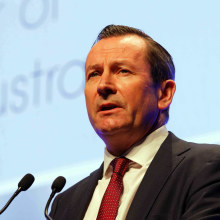China is pulling the plug on iron ore
There is not much that Scott Morrison and Mark McGowan will agree on in the months ahead. But neither will want to see China pull the plug on iron ore.
We flagged a few weeks ago that cycle highs were in place for iron ore. The rout has intensified since, with benchmark contracts down as much as 40 per cent.
Other base metals, such as copper and nickel, along with the oil complex, have also taken a hit, in line with a delta-led deterioration in global growth expectations.
In one way the downturn does West Australian Premier Mark McGowan a favour, as it provides cover to insist that the 2018 reforms to the distribution of GST revenue stay in place. Trevor Collens
Still, iron ore has taken the brunt, and may still have a lot further to fall.
For Australia, the timing could hardly be worse.
Iron ore exports added about 2.5 per cent to nominal GDP over the past year. It also aided fiscal repair, and provided a kicker to shareholders of the big miners, including the bumper dividends that were recently announced.
In Q2, iron ore comprised fully 42 per cent of merchandise exports, up from 32 per cent in the corresponding period last year. Australia’s next-largest merchandise exports (coal, natural gas, gold and beef) collectively comprised 23 per cent.
With the collapse in inbound tourism, and reduced education-related travel expenditure, iron ore exports were 3½ times all of Australia’s service exports in June.
For reference, oil accounts for about 75 per cent of Saudi Arabia’s exports, so Australia’s dependency is not in that league.
But iron ore, by itself, has the capacity to impart a very significant negative terms of trade shock, compounding the likelihood of recession.
Australia is heading back into recession
Go west
West Australian Premier Mark McGowan will be first on deck with this, as his state is due to hand down its annual budget on September 9.
This follows his decision in March to self-appoint as Treasurer. This raised a few eyebrows, but the arrangement was commonplace in WA before 2001. Moreover, the same applies in Tasmania.
Western Australia will be unique, though, among all states and territories, in achieving an operating budget surplus to June 30.
This may be in the order of $6 billion, or 2 per cent of gross state product. This assumes royalties from iron ore of about $13 billion.
Bear in mind that every US dollar increase in the iron ore price over a year improves the state’s budget position by about $85 million. For reference, the budget forecast $US96 a tonne in 2020-21.
State budget announcements rarely gain much national prominence. But McGowan’s remarks will be closely scrutinised, including by the treasurers of other states and territories nursing red ink.
In one way the downturn does McGowan a favour, as it provides cover to insist that the 2018 reforms to the distribution of GST revenue stay in place. This was authored by then-federal treasurer Scott Morrison, and played significantly in WA’s favour via a complex process known as horizontal fiscal equalisation.
Still, when McGowan took on the role of treasurer, he highlighted “there is a groundswell of effort among the states in the east to unravel the GST deal, and that groundswell is growing stronger every single day”.
It is doubtful Morrison would go as far as nixing the deal even if Western Australia refuses to open up and “live with the virus”. That would be politically toxic ahead of a federal election.
There should be no doubting the resolve of Beijing ... This is China’s brand of exceptionalism on display.
Nonetheless, the divergence in state budget positions was already stark (Victoria’s net operating deficit will be about 4 per cent for 2020-21), and the protracted lockdowns now in place will weigh further.
This argues for a conservative assumption for iron ore prices in WA’s budget. The problem - and this holds federally too - is that this may well be realised into next year.
China curbs
To be clear, we don’t know how far iron ore prices will fall, or for how long.
Yet there are hallmark signs of a cycle high being in place. Moreover, previous cycle lows were much lower than where we stand today (roughly $US60 in 2009 and $US43 in 2015).
Supply dynamics are, of course, relevant. The Brumadinho dam disaster in Brazil in 2019 illustrated this in the most tragic of ways.
But the price of iron ore will ultimately be determined by China. For reference, in Q2, fully 84 per cent of Australia’s iron ore exports were to China. Next was Japan at 6 per cent and South Korea at 5 per cent.
The lurch lower last week coincided with materially weaker macro data from China, along with confirmation that steel production slumped in July, breaking from traditional seasonal patterns.
On the macro side, floods have played a part, but more importantly, China is facing its own test with zero COVID-19, and at scale.
Containment measures were introduced from July 20. And Exante’s real-time tracking of alternative data sources, such as subway passengers, road congestion, intercity travel and box office revenue, confirms that August will be weaker again.
China has, however, bent the curve, with the daily case count topping out at less than 200 in early August (including asymptomatic cases).
Still, the cases have been widely spread across the provinces, which places an ongoing burden in terms of public health and safety measures, along with (ruthless) testing, tracing and quarantine.
The Ningbo-Zhoushan port in Zhejiang, the third-busiest in the world, has also been affected, and illustrates the ongoing risks to supply chains.
There should be no doubting the resolve of Beijing, however, in maintaining its zero tolerance approach to the virus. This is China’s brand of exceptionalism on display, made even more relevant by the proximity of the Winter Olympics in February.
Bing Dwen Dwen, the official mascot for the 2022 Beijing Winter Olympic Games is revealed at a ceremony at the Shougang Ice Hockey Arena in Beijing. Ng Han Guan
On steel, as part of its emission reduction strategy, Beijing has pledged to limit crude production to the 1.065 billion tonnes made in 2020. But China ran as much as 12 per cent above this baseline through the first half, implying that significant cuts are required through to the end of the year.
Whether this plays out will likely be decisive for iron ore prices. Still, there is clearly now a compliance push under way across all provinces.
Moreover, last Tuesday, President Xi Jinping’s “common prosperity” plan was interpreted by the Central Committee for Financial and Economic Affairs as calling for high income groups to “give back to society more”. This may evolve into a property tax that would weigh on steel demand.
Note too that on Thursday, China’s Iron and Steel Association proposed limiting steel exports to ensure domestic supply is prioritised. This may lead to further tariffs before the end of the year.
Bluster too
For Australia, there is also bluster. The Global Times, Beijing’s populist mouthpiece, ran a few articles last week going after Australia with characteristic enthusiasm.
Interestingly, this went beyond the typical mocking of Western media that suggest “Beijing cannot wean itself off the metal”. It additionally highlighted that Australia was being targeted in terms of steel exports from China.
In any event, we agree that with iron ore prices “returning back to a more regular range, the true state of China-Australia trade is likely to become clearer in the future”.
And to provide a sense here, Australia’s merchandise exports to China increased by 29 per cent from the second quarter in 2020 to the corresponding quarter in 2021. However, on an ex-iron ore basis they fell by 30 per cent, and many staples have been zeroed.
Not a pretty sight
These numbers will be well known to the Reserve Bank of Australia, as will the sensitivity analysis in the federal budget papers. There, the baseline assumption was for iron ore to fall to $US55 (free on board) on a linear pathby the end of March.
Treasurer Josh Frydenberg referred to this as a “very conservative” assumption at the time.
As things stand, it looks an increasingly plausible assumption. And in any event, the windfall that Treasury was looking at has already been significantly eroded.
This is problematic, as the federal budget will be taking a big hit due to the lockdowns, both in terms of tax receipts and income payments.
The Mid-Year Economic and Financial Outlook, due before the end of this year, shapes as a doozy, and may be the final say for the Treasurer before the election.
There will be less reason to call the budget forward now, and plump for a plebiscite in May. The budget is not going to be a pretty sight.
There will additionally be more net bond issuance than the Australian Office of Financial Management is planning for. This, along with the terms of trade shock, may prove sufficient for the RBA to wake from its hibernation.
If China does pull the plug, Australia will certainly need a much weaker currency.
- Forums
- Breaking News
- China pulling the plug on Iron Ore
China pulling the plug on Iron Ore
-
- There are more pages in this discussion • 11 more messages in this thread...
You’re viewing a single post only. To view the entire thread just sign in or Join Now (FREE)
Featured News
Featured News
The Watchlist
EQN
EQUINOX RESOURCES LIMITED.
Zac Komur, MD & CEO
Zac Komur
MD & CEO
SPONSORED BY The Market Online












